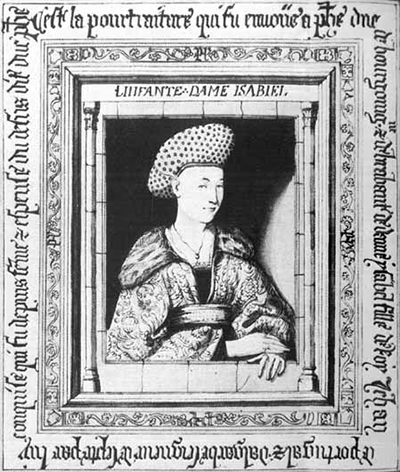Jan van Eyck's Portrait of Isabella of Portugal is one of several artworks from his career which have sadly been lost, with little chance now of being found. The centuries that have passed since mean we are unlikely to find out much more information about this painting than what we already have.
The artist worked for Philip the Good for a number of years and this role also offered him the chance to travel around Europe from time to time. He also served as a diplomat and so was someone who was highly intelligent and also curious about other countries and cultures. During a trip to Portugal he produced the portrait of Isabella who at the time was being considered as a potential wife for the artist's employer. What better way, before the age of digital art, to convey her look to Philip than to produce a portrait? It would have been a tricky commission in that the artist would have to be honest as to her beauty, whilst also pleasing the model herself. Van Eyck was considered one of the finest portrait painters in Europe at the time, and so if anyone was capable of keeping everyone happy, it would be him. There is more on his relationship with Philip the Good in our Van Eyck biography.
He made this visit in around 1428-1429 and so we can be more accurate about the timing of this painting than some of his others. There is plenty of records which describe the meetings that they made, on both sides. We believe that there were actually two portraits produced, just in case one of them was lost on the way back, which clearly was something of a concern back then if plans were made in this case. There was an outbreak of illness at the time which limited the meetings but the Dutch party was eventually able to return without becoming infected themselves.
The photograph shown here is of a copy which is believed to be fairly faithful to the original work by Jan van Eyck, and so can give us a good idea of how that piece looked. It remains within a private collection which tends to make it harder to access for further studies. This might explain why there continues to be a doubt around the precise date of this piece, although it is entirely accepted as having been similar to the original portrait from Van Eyck, and therefore still of critical importance in helping us to fill in some of the blanks that exist from his career. Having lived so many centuries ago it is hard to imagine much more information coming out about the artist that we were not already aware of, other than perhaps through advancements with scientific research which do manage to undercover new research about the old masters every now and again. Most of Van Eyck's paintings remain accessible to the public which is critical when considering his influence on the direction of European art as well as the relatively small nature of his oeuvre.




